
HEMINGRAY GLASS COMPANY
Cincinnati, Ohio (1848-1852)
Covington, Kentucky (1852-c.1890)
Muncie, Indiana (1888-1933)
Muncie, Indiana (1933-1972) [Owens Illinois Glass Co.]
Hemingray Glass Company is the best known and was the most prolific glass insulator manufacturer in the world. Although best known for their electrical insulators, Hemingray also produced many other glass items over the years, including bottles, fruit jars, pressed glass tableware, syrup pitchers (“molasses cans”) in milk glass and other colors, tumblers, battery jars, fish bowls, lantern globes, kerosene oil lamps, and much, much more.
Hemingray operated under several slightly different company names during its long history, first as Gray & Hemingray (1848-1856), then Gray, Hemingray & Bros. (1857-1860), Gray, Hemingray & Brother (1861-1863), Hemingray Bros. & Company (1864-1867), R. Hemingray & Company (1868-1869), and finally incorporating as the Hemingray Glass Company, Inc. in 1870.
Hemingray began as a small operation in Cincinnati, Ohio in 1848. A variety of glassware was produced in the late 1840s and very early 1850s at Cincinnati, including “perfumer’s ware”, chemical apparatus, apothecary furniture, “telegraph glasses”, lightning rod insulators, etc., as mentioned in period advertisements. No doubt other standard glass items of the time, such as oil lamp chimneys, lanterns, tumblers, etc., were made in quantity during those earlier years.
In 1852 a new glass factory was built just across the Ohio River – in Covington, Kentucky – and glassmaking operations were moved to that location. However, the business office/showroom remained in Cincinnati, until 1881 when it too was removed to a new building in Covington.
With the explosion of manufacturing concerns during the 1880s in the “natural gas belt” of central Indiana & northwestern Ohio, a new glass manufacturing facility was built in Muncie, Indiana and production commenced there on September 4, 1888. The exact year when actual insulator production ended at the Covington site is still undetermined, but it was likely sometime in the 1890-1894 period. The Covington factory also re-opened for a short time in the 1900-1902 period. The business offices remained at Covington until 1919, at which time all operation was moved to Muncie.

The Hemingray factory and business offices were located on Macedonia Avenue, in the southern part of Muncie. In 1933 the Muncie factory officially became the “Hemingray Division”, a subsidiary of the Owens Illinois Glass Company (listed as factory #26, and later, in about 1948, their factory number was changed to 86), but insulators made after that year continued to carry the “HEMINGRAY” name. Date codes were embossed on most insulators made after 1934, and the majority (but certainly not all) of post-1934 production was made in clear (colorless) or off-clear glass.
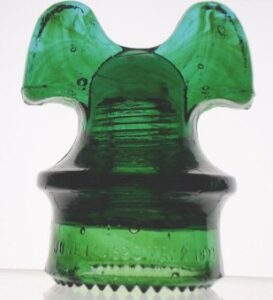
Glass building blocks, a major item made for many years, was discontinued in March of 1966 and production of insulators was discontinued in 1967, although the factory continued to produce television face-plates until closing permanently in 1972. (The very last glass insulators made were produced at the Indiana Glass Company factory located in Dunkirk, Indiana, using molds that had been moved from Muncie to that location).
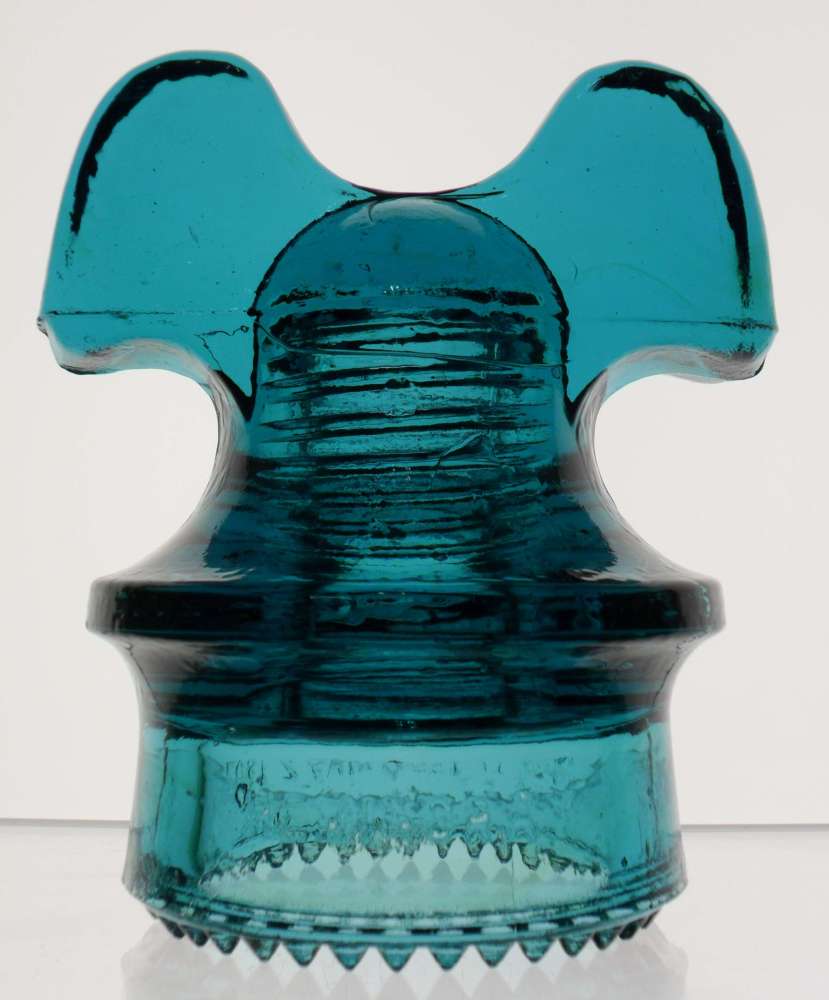
Embossings found on Hemingray-produced electrical insulators include “PATENT MAY 2 1893”, “PATENT DEC 19 1871”, “H.G.CO.”, “HEMINGRAY”, “LOWEX” , “KIMBLE”, and others.
The earliest insulators made by Hemingray have not been specifically identified but would almost certainly be circa 1850s threadless or possibly “Wade” types made for early telegraph lines. Lightning rod insulators, and various sizes of spool insulators were also made.
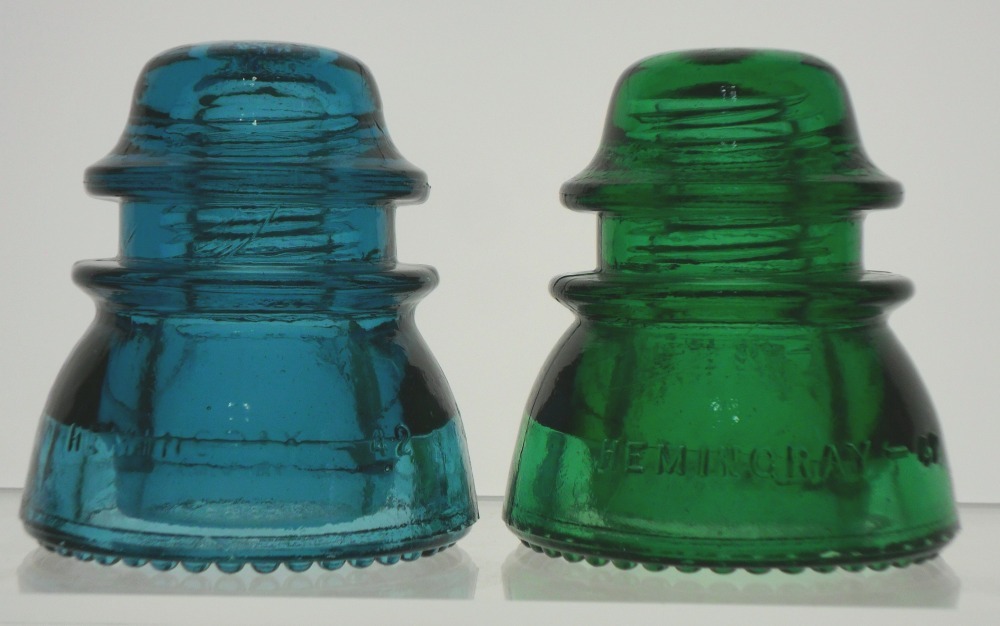
The HEMINGRAY-42
In 1921, the “Hemingray-42” style insulator was introduced which was an update/replacement for the Hemingray NO. 40 insulator. (The No. 40 had been in heavy production since 1911, for telegraph lines). The “new and improved” #42 model very quickly gained in popularity for standard open-wire communication lines, and was soon the most popular and common insulator made for both telegraph and telephone lines. Many railroad lines used them for their telegraph communications, and the style became the standard for A T & T long distance “toll” lines. The 42 is classed as a “CD 154”, in the “consolidated design” cataloging/identification system used by insulator collectors. Each CD number is assigned to a basic shape (profile/size), regardless of the exact embossed lettering, glass color or base type.
ADVERTISEMENT
The HEMINGRAY-42 is almost certainly the most common glass insulator ever manufactured, sold and used in the United States, if not the entire world. (The Hemingray No. 9 is considered by some to be the most common insulator, but I think the 42 has a slight edge). The Hemingray No. 9 style was produced from about 1892 to 1955 (63 years) and tremendous numbers were used across the country on local telephone line systems. A lot of the earlier 9s had already been dismantled, destroyed or discarded (from line upgrades as well as ice storms, windstorms, fires, BB gun vandalism, etc) long before the insulator-collecting hobby started to become popular in the mid-1960s, so it is harder to make a direct comparison on total numbers ever made, since so many 9s were already in dumps and landfills before the wholesale dismantling of the railroad telegraph lines was fully underway during the 1970s-1990s. So, today the 42s are much more commonly found in such places as antique malls and flea markets.
The earliest Hemingray-42s have sharp drip points, which are believed to have been phased out circa 1923 or 1924. The RDP (round drip point) version probably came into production sometime in 1924, although admittedly that is just an “educated guess”. Tremendous numbers of Hemingray-42 insulators with RDP bases were made, for the most part in aqua or “Hemingray Blue” (a richer blue-aqua made by Hemingray, as well as Ball Brothers, maker of the “Ball” fruit jars) during the 1924- c. 1930 period.
The transition to off-clear glass began sometime in the 1930-1933 time period. By 1933 virtually all Hemingray-42s were being made in off-clear, very pale “ice blue”, or clear glass. Date codes were began to be implemented around 1933 or shortly afterward, that being the year that Owens-Illinois acquired ownership of the Hemingray facility. Judging from date codes, “Ice blue” (an off-clear with a faint bluish-gray tint) seems to have been made a lot during the year 1935. The majority of clear and off-clear glass Hemingray-42s (from the years 1934 to 1962) carry mold/date codes. Typically, the first number (before the dash) represents the mold number, the second number (s), after the dash, indicates the year the mold itself was made. Any dots (if present) after the second number is added to find the year the insulator itself was molded. For example, 12-41::: [six dots] would indicate an insulator made in 1947 from mold # 12. However, not all 42s have this type of date code, especially some of the earlier units dating between 1930-1940. For more information, please see a query I received which is posted near the bottom of this page.
(And for further information on date codes found on Hemingray insulators, check out this webpage on Christian Willis’s site) :
Information page on how to interpret HEMINGRAY mold and date codes!!
The 42 continued in production until at least 1961, as that is the latest date code seen (so far). If you know of a Hemingray-42 which was made later than 1961, please contact me with the exact date code information! [Edited 3/10/2025: Thank you to collector Houston Gilliland who has confirmed that at least one Hemingray-42 insulator exists that was made in 1962. It carries the mold #18 and “52” plus 10 dots! ]
As stated earlier, the Hemingray-42 is almost certainly the most common U.S.-made glass electrical insulator in the world. The great majority are found in aqua, Hemingray Blue or clear glass. Less common are examples in shades of true green (i.e., showing no blue influence in the color) or in two-tone (half aqua, half green). A few examples are known in carnival glass, white milk glass and opalescent (cloudy off-white). It is likely that at least one Hemingray-42 can be found in nearly every large antique mall in the country. Even accounting for their commonness, nevertheless these are authentic relics of a bygone era in America, and some of the earliest examples can now be considered true antiques. (Officially, an antique is an object at least 100 years old………..that status was reached in 2021!)
Unusual Hemingray-45 (CD 155) insulator that carries an apparent 1970 date code!
This insulator (theoretically) should not exist. But it does. Perhaps this was made at the Indiana Glass Company factory in Dunkirk, Indiana? It is known that a relatively small number of insulators were produced by Hemingray at the Dunkirk facility (with molds shipped over from Muncie) in the very last days of Hemingray insulator production, but there is not a record of any insulators being made as late as 1970 – so this is an apparent anomaly that hasn’t yet been satisfactorily explained. The insulator carries the mold date code “15-54: : : : : : : :” on the reverse skirt. (15 is a mold number). The 54 + 16 dots indicates the year 1970. (THANK YOU to collector David Boothroyd who has kindly given my permission to post these photos here).
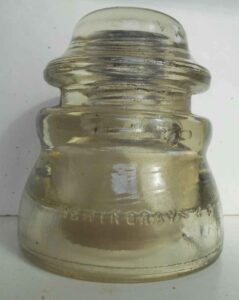
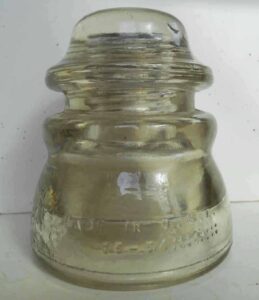
ADVERTISEMENT
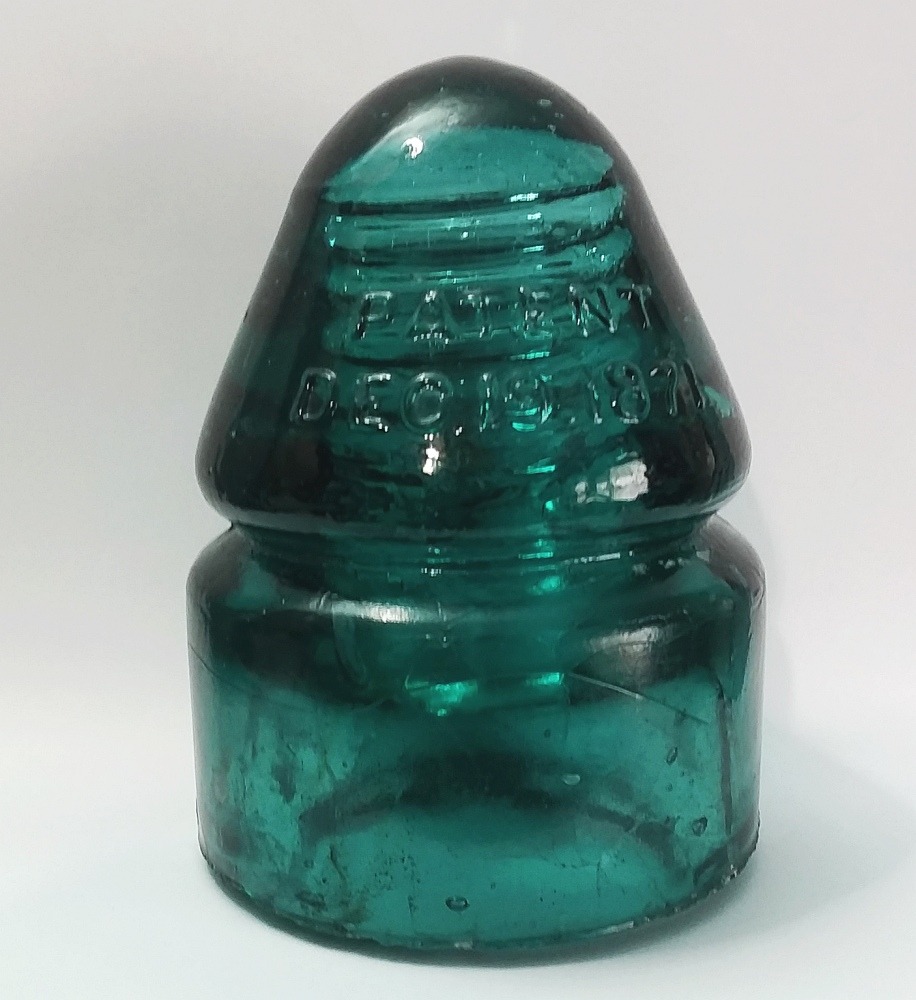
Hemingray is well-known among antique fruit jar collectors for several types of jars they manufactured in the mid-late 1800s and up into the early 1900s. The most famous of those would be the “GLOBE” brand fruit jar which is found in a range of colors, including, of course, many shades of aquamarine, as well as several shades of amber including honey amber, yellow amber, orange amber; also olive green, black glass, clear and cornflower blue.
Many types of insulators marked “PATENT DEC 19 1871” were manufactured from approximately 1871 into (in some cases) the early 1890s.
Tremendous numbers of insulators embossed with the lettering “PATENT / MAY 2 1893” were made from 1893 through at least 1910, (i.e. the period of 17 years during which the patent for Hemingray’s “drip points” was in effect), and probably even for several years afterward on a few insulator styles.
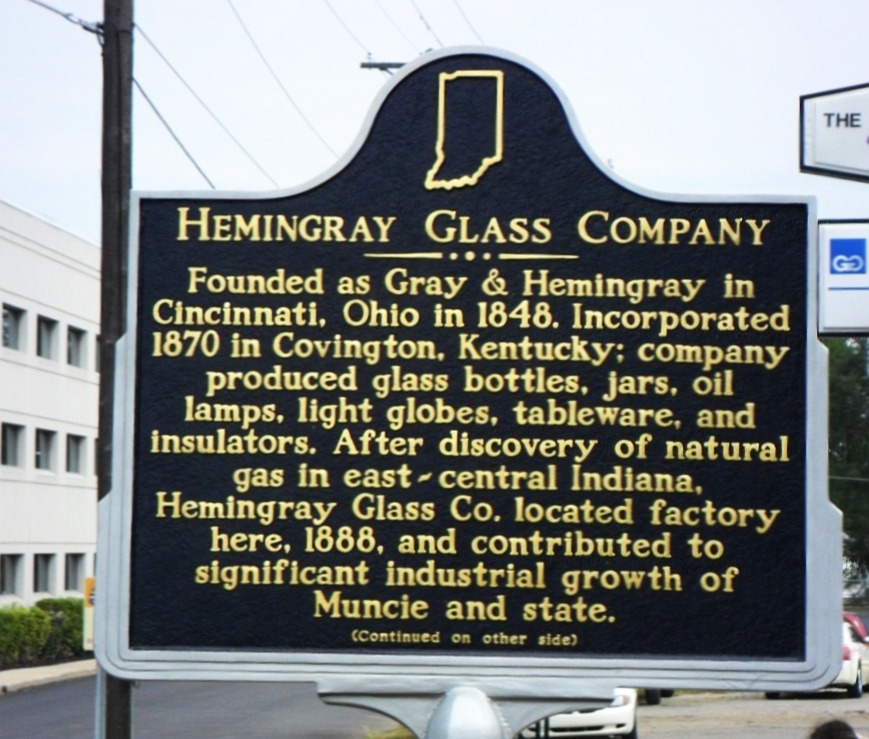
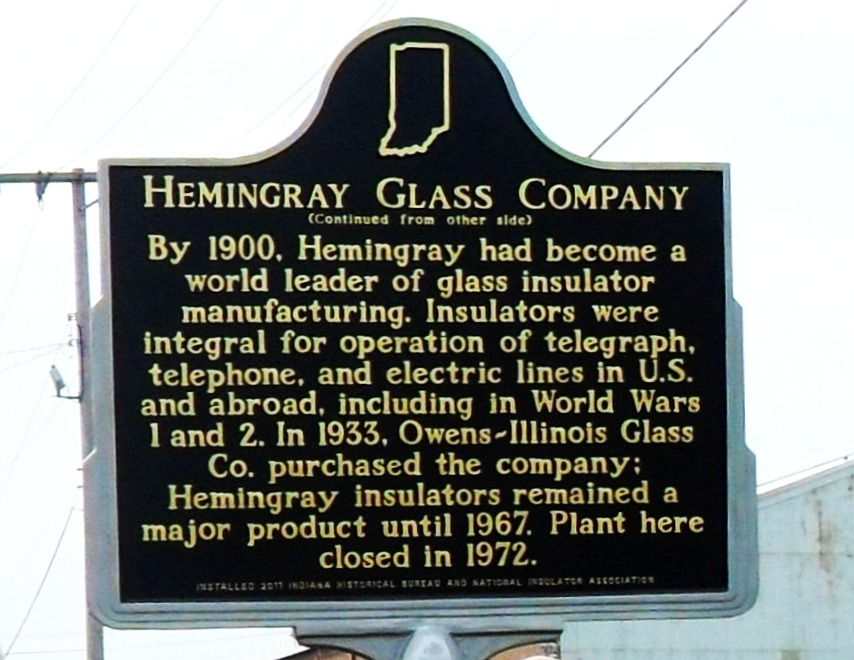
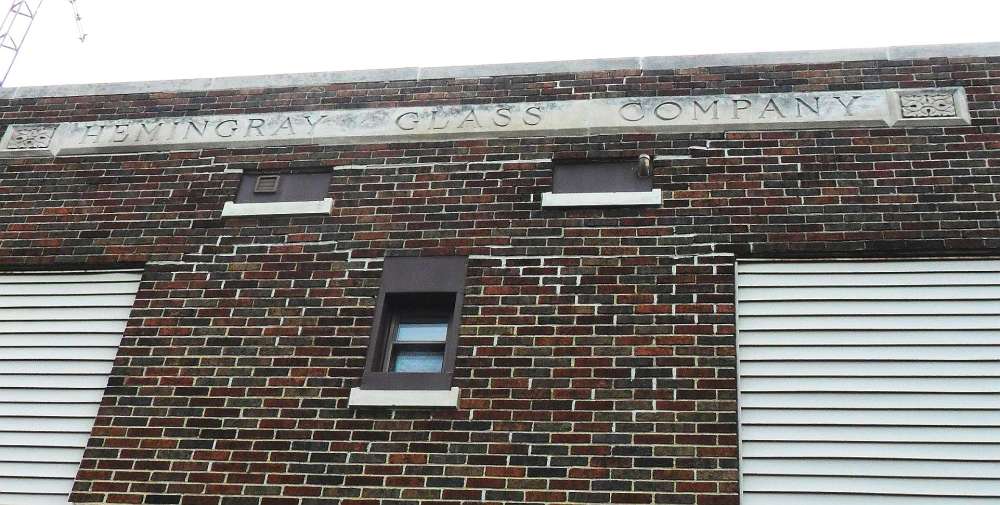
For more info on Hemingray and Hemingray products, check out these great websites:
Hemingray.com (run by Bob Stahr)
Hemingray.net (run by Shaun Kotlarsky)
Hemingray.info (run by Christian Willis). Christian’s website has lots of GREAT information on the known styles and embossing variants discovered so far among Hemingray-manufactured insulators. If you have questions about a specific piece, this is an excellent site to explore for more in-depth information!
NOTE: for a basic list of glass factories in the United States that are believed to have made glass insulators at some time in their history, please go to the “Glass Insulator Manufacturers” page.
For more general information on insulators, please check out my article here:
GLASS INSULATORS – GENERAL OVERVIEW.
For some basic information on the “HEMINGRAY No 9 // PATENT MAY 2 1893” embossed telephone line insulator, a “pony” insulator may in large quantities by Hemingray, please check out my webpage here:
HEMINGRAY NO 9 // PATENT MAY 2 1893
For a list of embossings (markings) seen on glass insulators, please check out this page: Glass Insulator Embossings.
Click here to go to my website HOME PAGE.
Note: I want to extend a special thanks to Hemingray collector, researcher and author Bob Stahr, as some of the information presented here concerning Hemingray, including company names and timelines, was supplied by him in emails and personal communications. Other sources of information include David Dale, Clarice Gordon (known under her pseudonym H.G. “Bea” Hyve), Glenn Drummond, Alice Creswick (author of The Fruit Jar Works), John & Carol McDougald, Nathan “Woody” Woodward, and various articles in Crown Jewels of the Wire magazine.
ADVERTISEMENT


Hi,
I have a Hemingray insulator that has Hemingray on one side and NO 18 on the other. No other words whatsoever. It has sharp points on the bottom and is a dark green color, with a VERY slight blue hue. It has an original wood type of screw still inside it. I can’t find any description that even comes close to matching it. It doesn’t say made in USA, no patent marking, no date, etc. Do you know anything about this one? 🤞 Thank you in advance for any help!
Jaquelyne
Hi Jaquelyne,
Your insulator is a type classified as a “CD 134” in the “CD” (Consolidated Design) system of glass pintype insulator identification used by collectors. There are many minor lettering variations of the Hemingray Number 18 style. Your insulator is listed as embossing variant number [020] in the price guides, and you can see that [020] listing here on this page from the website Hemingray.info : https://www.hemingray.info/database/detail.php?id=134 .
The “SDP” means “sharp drip points”, the “points” on the bottom of the insulator. The most common color is aqua (blueish green) and I suspect that it the color of your insulator, although sometimes the aqua may be a bit darker, or lean a bit more to a green or blue.
The photo of the insulator shown on that particular webpage is only an example of a Hemingray CD 134 – keep in mind there are many different variations of the exact lettering that have been found, and the photo shows just one of them.
You can do searches online used keywords such as “Hemingray” and “CD 134” to see some of the varieties that are out there to be discovered!
Thanks for writing and I hope this will be of help!
David
Hi I found 2 boxes, 80+ pcs, of the 42s with no manufacture code on them. These were in my grandfathers shed. I understand from the comments above that they are most likely from the 20s – 30s. How would I go about finding out the value of these? They are getting close to 100 yrs old and would like to know if I just have some neat craft items or something to look more into.
Thanks, Tim
Hello Tim,
The “HEMINGRAY – 42” style of insulator was the most common type made by Hemingray, made over a period of at least 40 years. Most of the earlier examples (and I believe you probably have pieces that would fall under that category) were made in aqua (bluish green), “Hemingray Blue” which is a bluer shade of aqua and shades of off-clear (ice green or ice blue).
Most of those would generally date from 1921 to 1930, and are extremely common. Most of the 42s from that era do not have mold codes on them. In general, most longtime collectors would consider the “true market value” to be in the 25 cents to one dollar range, simply because there are so many still around. That said, they are nearing one hundred years old and are still authentic artifacts of an earlier United States, from the great “roaring 20s” decade! These insulators do appear on ebay and other sites in large numbers, and the prices asked can range from a dollar to much, much higher, although in those cases the sellers may not be aware of their commonality, their value, and may have them priced much higher than their market value to collectors would really warrant.
There are many “repurposing” projects that people are doing with them, including as paperweights, candleholders, in sconces, made into lamps and candelabras, as part of chandeliers and other items. There are a number of sites online on which crafters are making items using these common, but older insulators. They are also being sold at flea markets and it is gratifying to see brand new uses for old, otherwise “obsolete” glass objects. I hope this helps a bit. Thank you for writing!
David
I have a ceramic insulator with an R or B encased in a oval on the bottom half of it. Can you help me identify what type it is
Hi Spencer,
Judging from your description of the mark, your insulator was made by Ohio Brass Company of Mansfield, Ohio. The “B inside an O” was their trademark, and that mark appears on dozens, if not HUNDREDS of different styles and sizes of porcelain insulators made by Ohio Brass. You may have to search through some sites listing porcelain insulators for more info. Porcelain insulators are classified by collectors in what is known as the “U-number” identification system. Porcelain insulators are usually more difficult to classify and identify compared to glass insulators. There are several books out there, written by collector and researcher Elton Gish, that lists porcelain insulators along with drawings/diagrams showing their profiles and dimensions. Hope this helps,
David
I have 4 Hemingray 3-59 insulators. Are they railroad? I can’t find a date or anything on this number. Thank you! Jill
Jill, please check your email inbox.
David
I have over 100 hemingray glass pieces from 1802 till 1967
Paul, either you have a typographical error there, or have misunderstood something. Hemingray wasn’t in business until 1848, and no items were actually marked with the name “HEMINGRAY” until perhaps the very early 1890s, such as on the very oldest smooth-base HEMINGRAY NO. 9 style insulators.
Can you clarify your comment? Thank you,
David
I have a pint size beer bottle that is an olive amber color with H.G.CO. on the bottom, could you tell me where I could find additional information about this bottle ? Thanks
Hello Dave,
I’m sorry this reply is so late. I approved your post for publication and neglected to answer it on the site. Hemingray Glass Company made some “export beer” style beer bottles with “H.G.CO.” embossed on the bottom, and they were made in (at least) two sizes, the so-called “quart” and “pint” bottles. They are similar to other “export beer” bottles of the time period and bear ‘blob top’ finishes. Other bottles of similar appearance are found, especially in the western states, with base markings such as “M G CO”, “F H G W”, “R & CO”, “L G CO”, “M G W”, “KY G W CO” and others. The “H.G.CO.” beer bottles are not common, but a few have been found around the country and are in collections. Most have been found in shades of amber glass.
I am assuming they were made sometime in the 1870-1890 time period. Most were probably made at the Covington, Kentucky glass plant, although some bottles might have been made at the Muncie IN plant and those would date after 1888. You might find a few pics or other info on them by checking the sites Hemingray.com (hosted by Bob Stahr) and Hemingray.net (hosted by Shaun Kotlarsky). Hope this helps a bit.
Take care, David
I have a old insulator from Hemingway with 14-49 C.S.C. This is clear, looking for info and mfg date.
Hello M.E.,
The insulator was made by Hemingray, not Hemingway. It is classed as a CD 128. (You can find more info by searching Google with the keywords: CD 128 Hemingray insulator). The “49” is date code for the year the mold was made (1949). If there are any dots after the “49”, add them to find the year the insulator itself was made. If there are no dots, it was made in 1949. The “14” is a mold number.
David
Good day: I have two #42 Aquas with Sharp Drip Points one of which has a large clear and distinct 1 on the top. I’ve been unable to understand what this signifies. Thanks Mike Long
Mike, no one is positive of the meaning of the large “1” that is found on the dome of some Hemingray-42s. They are much scarcer than ones without the number on top. I am guessing it was just a mold number, but I really don’t know.
Best regards,
David
Hello, my name is Andrew, and I have a jar that resembles the one this person described. It is a one quart aqua blue mason’s patent Nov 30th 1858 with the HGCO emblem on the reverse. It has the ground down mouth as well. I am trying to date it more definitively, and I believe that you can help. The mold mark is 28 on bottom. Is this a rare jar? If so, how rare? Any more info than I found here would be greatly appreciated. Thank you, -ANDREW
Andrew, I understand those “Mason’s Patent Nov 30th 1858” types jars with the HGCO monogram on the reverse are indeed products of the Hemingray Glass Company. I can’t date them exactly but I assume they are from the 1870s-1880s period. There are several slightly different monogram styles, and they are listed in the official fruit jar “Redbook” as #1851, #1853, and #1854. I can’t say how rare they are, but they are definitely not a common jar.
David
I have 2 hemingray-42 insulators that have made in USA on them but no numbers not sure what that means
Blaze, I assume you meant that you have aqua (blue-green) Hemingray-42s that do not have any mold numbers or date codes on them. Those are the earlier versions, made circa 1921 to around 1930, and they don’t have any embossed markings other than “HEMINGRAY – 42” on one side, and “MADE IN U.S.A.” on the other. Later versions of this type of insulator (usually in clear or off-clear glass) are more likely to carry mold numbers and date codes. If you meant something else, please elaborate.
Best regards,
~David
I have a clear mason type jar with a hemingray 4 on the base…. it has a smooth lip and the glass is very wavy looking….the jar is unmarked….would you have any information about this jar…..unable to find it in red book of fruit jars…….thank you
Ralph, I contacted you by email but have not received a response. (Perhaps my email was sent to your spam folder?) You can email me a pic of the jar if you wish.
~David
It is rough
Shawn, with a ground lip, and in an ordinary aqua color (some shade of light blueish-green), your jar most likely dates from sometime in the 1870s-1900 era. Unfortunately there is no way to pinpoint the year any one of the old “MASON’S PAT NOV 30TH 1858” jars were made. Many of the ‘1858’ and other Mason-type jars are found with (more recent) “BALL” or “ATLAS” screw-type zinc lids (with the milkglass disc insert), which was a fairly standard replacement lid for jars of that size/type.
~David
i found an aqua blue hemingray 16 insulator with drips on the bottom of the petticoat it is filled with many bubbles. can you identify the CD number?
Albert, that would be a CD 121. Same general shape as the insulators marked “AM TEL & TEL CO”.
David
We purchased a qt mason jar from a flea market with the nov 30th 1858 on front. It appears to be a clear greenish color. It has it looks like the letter I or Roman numeral one on the bottom. Can you date this bottle. It also has an old ball screw on top
Shawn, I’m sorry but there is no way to date it. The “MASON’S PATENT NOV 30TH 1858” style jars were made for well over 50 years by hundreds of glass companies. Not counting the new repro’s sold in the last few years, most of them coming from Asia…….China and India.
Is the lip rim “ground” (rough as if ground on a grinding wheel or with rough sandpaper), or is it smooth?
David
Hi! I have a 1 oz glass with a glassmark on the bottom of an H in a circle. I have heard that this is a Hemingray mark from between the 1920-1940s, but I can’t find much info on anything except insulators. Anywhere that would have such information? Thank you for gathering such a vast amount of information for us glass history buffs!
T. J.,
I have doubts that the glass was made by Hemingray. You might try contacting Bob Stahr, webmaster of Hemingray.com, for his opinion.
~David
Hello. I have a green Hemingray insulator that is marked with the name and a -19 on one side and Made in the U.S.A. on the otherside. Can you give me an estimated date of production and what this one was made for? And, how do I find the value and where can I sell to collectors?
Thanks,
Desiree McKinney
Hi Desiree,
Hemingray-marked insulators with the phrase “MADE IN U.S.A” are believed to date after 1919. I am assuming your insulator is a blueish-green (aqua) color, not a “true green” with no hint of blue in it. Most aqua insulators made by Hemingray date up to the circa 1930-1932 period, as they began switching over to clear glass during the early 1930s. So c. 1919-1931 would be the time span I would suggest for your insulator.
The Hemingray-19 is a type of “signal” insulator, often used for relatively low-voltage electric lines, railroad signal lines and fire alarm circuits. They were sometimes used on ordinary telegraph and telephone lines. I try not to give advice on values, other than to suggest you search ebay over a period of time and see what actual examples of any particular insulator sell for (actual “Completed Auctions”, not minimum bids or “buy it now” prices which are often greatly over-priced!) . Most of the Hemingray-19s were made in aqua and they are very common. However, other, more unusual colors are also found, and they are much higher in value.
Best regards,
David
Hi David,
I have what I believe to be a Hemingray CD 145 Beehive double petticoat with the following embossing: H.G.CO with the word PETTICOAT on the opposite side of the skirt. It has a B embossed on the top of the dome. This insulator is light green. Would you be able to give an approximation as to when this may have been made. I am a fairly new collector and this is quite different from the other Hemingrays that I have.
Hello Kevin,
You have the earliest style of beehive telegraph insulator made by Hemingray. They were made from APPROXIMATELY 1886 to 1895, (no one knows for sure, but that is probably about the best guesstimate Hemingray researchers/collectors can give), at both the Covington, KY and Muncie, Indiana factory locations. They are most commonly found in medium aqua shades and many slightly different shades of light green, but many other colors have been found including sapphire blue, light pastel blue, orange amber, yellow amber, true medium and dark shades of green, clear, off-clear, purple, and white milkglass (one example known of that color!).
They usually bear a “shop letter” above or below the embossing on the front or rear, and/or with a letter on the dome. Some bear no shop letters at all. The shop letters known are A, B, C, D, E, “upside down L” (F without a crossbar), G, H, I, J, K, L , M, and backward N. There appear to have been at least 3 or 4 slightly different molds manufactured for every letter except the upside down L. They are very popular with collectors because of the wide color range and the shop letters.
It is assumed that around 1895 (give or take a year or so) the very slightly narrower “H.G.CO.” beehive type WITHOUT the “PETTICOAT” lettering (and usually with an “H” on the top of the dome) was phased in… which soon became the most popular telegraph line insulator made at Hemingray for a number of years……probably to about 1911 when the Hemingray No. 40 was introduced.
Hope this will be of some help!
David
Hi David,
Thank you very much that is extremely helpful and interesting. Your site is great!
Kevin
Hello David… Real quick.. I live and grew up on the NYC man “airline” and a lot of the insulators are soooo varietied. The one I first ask of is my Hemingray-42 but the number 2 is flipped over.. never seen one like that before.!!??? 2nd.. what are those 4 clear insulator owens Illinois cluster sets time frames? I seen 2 or3 of these aluminum frames with the skinny insulators and each one of the 4 has the symbol and a #58. Lastly. We live near the old Toledo and western trolley line near Pioneer and Fayette., the green insulator skirt is almost double diameter than an average hemingray and the word OHIO is molded in it, however it’s missing the other 1/2.
Hi Christopher,
You have found an example of a mold-maker error…. the Hemingray-42 with the “backward 2” is much harder to find, and is worth a premium over the normal ones.
The large insulator with the word “OHIO” embossed on it is a CD 302. Search google with more info on the “CD 302” power line style insulator made by Hemingray. There are several slightly different variants of that type, one is marked “MUNCIE TYPE” or “MUNCIE”, others are marked “OHIO” along with the standard “PAT MAY 2 1893” embossing which refers to the patent issued to Hemingray for their “drip points”.
I am guessing you are talking about a small clear “spool” insulator made by Owens-Illinois, it is classed as a “CD 1049” and was made in the 1950s or possibly into the early 1960s. I am guessing yours has a date code for 1958. If there are any dots after the “58” add them to get the actual year the insulator was made. I am not sure of how late they were made, but they are definitely one of the more recent, modern types of glass insulators made at the Hemingray factory in Muncie, Indiana.
Best regards, David
My father-in-law passed away recently and he was a collector of glass and ceramic insulators. Probably had close to 100 of them in excellent condition with many styles and colors including glass and porcelain insulators. I’d like to find a source of information that can help us understand the value of his collection. I really appreciate your site with all this information. Any tips you can provide on determining their value would be greatly appreciated.
Dave, the majority of insulators found do not have a high value (most ranging in the 50 cents to 5 dollar value range). But there are also quite a few that are much scarcer and have values that range into the hundreds or sometimes even thousands of dollars. My site is not intended as an appraisal site. Your question is very difficult to answer in a brief way since the field of collecting glass and porcelain insulators is very wide.
There are many websites that give information on various types of insulators. Here is a basic page with some of the most commonly asked questions on insulators….
https://www.insulators.info/general/faq.htm
Here’s a good site and this particular page has lots of basic questions on Hemingray insulators:
https://www.hemingray.info/database/faq.php
I hope this will be of help,
David
I have a clear Mason’s Patent Nov 30th 1858 jar with H47 on the bottom of it, can you tell me if it was manufactured by Hemingray company?
Hi Debbie,
No, it was not.
David
I’m doing a school project, and I need to know what a glass insulator does (or did). My group would appreciate answers!
Hello Bob,
I don’t profess to be an electrician, scientist, or engineer; I’m just a glass collector (and interested in the history and use of glass). But, to answer your question as simply as possible, insulators were used to “insulate” electrical lines including lower-voltage communication lines (telephone or telegraph), up to and including higher-voltage lines that carry electrical power. The word “Insulate” in this instance basically just means to help prevent, or greatly reduce electrical current loss over distances. If there were no insulators, the electric current passing through the metal wire would “leak” away at every point where the wire was touching a post or pole, especially during damp weather. Soon the current would be reduced to practically nothing, and it would be impossible or difficult to carry the electrical current very far. The material GLASS itself is an insulator, it resists the passage of electicity. That is, electic current does not easily go THROUGH glass. Nowadays, lots of insulators are still in use on utility lines, but MOST of them are now made of porcelain (some people would call them “pottery” or ceramic) or high-grade plastic formulas. Just for curiosity’s sake, try looking around your neighborhood and see if you can spot insulators overhead on electrical power lines. They are usually gray, white or brown in color. Some are smaller “pin types” and others may be larger “post insulators”.
Glass insulators are now almost obsolete in the United States, although some of them are still in service here and there around the country. And some countries around the world use larger styles of glass insulators for high-voltage power lines even now.
Please check out my webpage on Glass Insulators (in general), plus there are gobs of webpages online where insulators, both glass and porcelain, are discussed in more detail.
I hope this will help on your project! Take care,
David
Hi
I have a HemingRay 42 with the back Made in the USA. On the dome is 1. Do you know why. Thanks
Bob, no one is 100% sure what the dome number ‘1″ signifies which is seen on THE TOP of some of the HEMINGRAY-42s. It might have been meant to signify a particular set of molds used on a particular automatic insulator-pressing machine. Again, the purpose (in the case of THESE PARTICULAR INSULATORS!!!) is not certain at this time.
David
I have the aqua blue HEMINGRAT – 42 and on the other side made in the U.S.A but there is no other numbers on it. What does that mean and when would it have been made? It is the large insulators.
Hello April,
I assume your writing “T” instead of “Y” in “Hemingray” is a typo. “42” is the “model number” of that style insulator. The aqua and “Hemingray Blue” (stronger bluish aqua, some people call it “turquoise”) insulators marked “HEMINGRAY – 42” on one side and “MADE IN U.S.A.” on the other side are the most common variants of this style of insulator. They were made in very large quantities and those colors generally date from 1921 to around 1930. It is impossible to assign an EXACT year of manufacture to any of the aqua or Hemingray blue specimens. (No one is absolutely positive when the last aqua 42s were made, but probably circa 1930-1931). In later years, when mostly clear or off-clear glass was used, mold numbers and/or date codes will be seen on most examples. I hope this helps answer your question.
~David
Hello
I have several of these Hemingray insulators. Some have the name with a 9 and they are stamped 31-52 with a colon. Does the 9 signify 1939? Thanks
Hi Jerry,
No, the “9” is a model number (style number) assigned to that particular type of insulator made by Hemingray Glass Company and does not indicate the year it was made. The number 9’s are “pony insulators”, smaller types used primarily (but not always) on local, short distance, low voltage telephone lines. On older insulators, the wording is typically “HEMINGRAY / NO. 9”, on more recent examples (usually in clear glass) the phrasing is usually “HEMINGRAY-9”. The numbers on the other side of the insulator (such as 31-52, as in your case) is a combination mold and date code. (Please see the comments farther down on this page where I have discussed this in more detail in several posts). Basically, the “31” is a mold number, identifying the exact mold the insulator was produced in, and the “52” is a date code indicating what year the MOLD ITSELF was made (1952). If there are any dots to the right of the date code, add one year for each dot to arrive at the year the insulator was made. In your case since there are just 2 dots, that particular insulator was made in 1954.
~David
I just found a 42 with 0_4: on it. Im pretty sure I have that figured out but I can’t seem to find any information on what the 52 under “made in America” is. Does any one happen to know what that means?
Hi J, The “52” underneath the “MADE IN U.S.A.” is a mold number. These insulators were made in such tremendous quantities that many different “Hemingray-42” molds were being used simultaneously to produce them. Each mold (in this instance) was engraved with a mold number as identification, so if there were any problems with the finished product, the mold involved could be quickly identified just by checking the mold number on the insulator. (Over the years, there was some variation in the presence/absence of a mold number, and/or where it was placed on the insulator). Hope this helps,
David
I have acquired one that as an 8 as well.under Hemminggray – 42. It is a little different in that it says 0-8 and then 5 dots. On the opposite side it says 18 under made in USA. Others have said they just had the 8 or 4 without the 0. Do you have any idea what the 0 before the 8 might mean?
Hi Greg,
OK, first of all, I want to make CLEAR that no one is ABSOLUTELY certain what the early date codes signify, but from information put out by N. R. Woodward and other researchers, it seems the chances are very high that the “O” was engraved on many insulator molds, such as the Hemingray-42’s, around the time that Owens-Illinois Glass Company took over the Hemingray factory (which occurred in 1933). Some of these Hemingray-42s, usually in an off-clear glass, are marked with just a “O” immediately below the “HEMINGRAY- 42” marking. Others have additional markings such as O-4 or O-8 (with or without dots). The “O” is believed to be an initial for “Owens-Illinois” and the “4” is believed to stand for “1934”. This would make sense since 1934 is the year after Owens-Illinois took over. If an insulator has an “8” it is believed to have been made in 1938. (Of course, add any dots that might be present to the right of the 4, or the 8, to find the actual year an insulator was made). Your insulator was made in 1943. (8 + 5 dots). This system of date codes started changing gradually (on some insulators) around 1938, such as on the CD 155s (Hemingray-45).
Basically, this would be the proposed interpretation for Hemingray-42s of this era (in clear or off-clear glass):
O 1933
O-4 1934
O-4. 1935
O-4: 1936
O-4:. 1937
O-8 1938
O-8. 1939
O-8: 1940
O-8:. 1941
O-8:: 1942
Hope this helps, David
Hello, I have several Hemingray insulators that have 9, 12 or 16 on them, all in the aqua color. Three have the sharp drip points and one has rounded drips. Can you give me an idea where I could find information on these? Thank you!
Hi Laura,
The best site on the internet that discusses and lists all (or practically all) known Hemingray insulator styles and variants is https://www.hemingray.info. This site was created by collector and researcher Christian Willis. I would suggest you browse around the entire site, but in particular, this specific page lists the most commonly seen styles including the No. 9, 12 and 16: https://www.hemingray.info/database/commons.html.
I hope this will help! Thanks for writing~
David
Hi David,
I have a Hemingray Insulator, it is a pale light green that reads HEMINGRAY 20-41. I totally understand from your instructions above that is mold number 20 made in 1941 and the insulator manufactured in 1942. On the opposite side it reads C,S.A. any thoughts as to what that stands for? Also on the inside where the threads are it is lead what if any is the reasoning behind the lead. And thanks for such an informative site!
Hi Chuck,
From your information, the Hemingray style insulator you have sounds like the “CD 128” in the “CD number” classification system used by collectors. You can google that and see various examples of that style of insulator. Besides the Hemingray versions, the CD 128 was also made in LARGE quantities by Corning Glass Works, and their version is marked with the PYREX brand name. Whitall Tatum also made some of them, as well as Kerr, marked with “C S C”.
The insulator type you have is found with one of three different “CS” markings, including either C.S.A., C.S.O., or C.S.C. Basically, the “C S” stands for “Circuit Carrier: Steel pin” but no one is sure what the third letter indicates. (Occasionally, a myth has circulated that the CSA stands for “Confederated States of America” which implied those insulators were Civil War era. Obviously, not so!)
The “brass bushing” or “thimble” insert (it looks like lead but I think they are actually made of brass) was put in place by machine, at the time the insulator was made and the glass was still very hot. It was included to make sure the threads were perfectly standard and no slight changes in the dimensions occurred during extremely hot or cold weather, and (I assume) as an additional strengthening/buffering agent since the insulator would be installed directly on a steel pin.
Here is a link to Christian Willis’ Hemingray.info site, where he discusses the CD 128: https://www.hemingray.info/database/detail.php?cd=128.
Also, check out this page from a 1935 article: https://reference.insulators.info/publications/view/?id=4460
Scroll down to the paragraph entitled “Insulators to 27 Foreign Countries” where there is a brief mention of the process of automatic production of that type of insulator and addition of the metal thimble.
I hope this helps, and thanks for your query!
David
Hi David,
I just acquired a No. 42 (bluish green) with no date. Can you help me to date it or determine its history?
Thanks!
Hello Deb,
Unfortunately, there is no way to date the aqua-colored Hemi-42s. As you probably realize (but I will repeat it here for other readers), the “42” is a model (style) number and gives no info at all concerning date of production.
All that can be said is that the aqua (turquoise or blue-green, as well as Hemingray Blue, and some are found in true green) 42s date from 1921 to around 1930 or 1931. If it has sharp drip points, it probably dates from somewhere in the 1921 to 1924 time period. If it has round drip points, it probably dates sometime between 1924 and 1930. Those dates are not “written in stone” but are as close to accurate as collectors can be at this time. None of the aqua 42s have any type of production date codes on them. After around 1933, the 42s were mostly being made in clear or off-clear glass, and by that time, date codes were coming into use.
Best regards,
David
Hi David,
I just acquired an insulator and am trying to date it. Similar to Jim above, I think it’s an early code variation. Under Hemingray – 42 it says 8 with 7 dots. I am unclear as to what would be the mold number vs. the date? On the other side is 10B under Made in the USA. If you could clarify, I’d appreciate it. Thank you!
Nicole
Hi Nicole!
Yes, that’s another one of the earlier Hemingray-42’s with a different type of code. In these cases, the “8” is believed to stand for 1938. Most Hemingray-42s with this style of code configuration will have *either* a “4” or an “8” (standing for 1934 and 1938, respectively, years when new sets of molds were introduced during that time frame) as part of the date code. The 4 or 8 may (or may not) be followed by dots. In your case the insulator mold was produced in 1938, and the insulator itself was molded in 1945 (1938 plus 7 dots). For each additional year that these molds were used, another tiny “hole” was drilled into the inside surface of the iron mold, which appears as a raised ‘dot’ on the surface of the finished glass insulator.
I have a No.42 from that same mold set. In the case of the example in front of me, the “8” is followed by 7 dots, (same as yours) BUT the only difference being a different mold number/letter combo. The 10B is a mold number, serving to identify the exact iron mold used. On the example I have, the mold number is 6A. On these particular insulators the mold number (or mold number/letter) is indeed on the REVERSE side, positioned underneath the “MADE IN U.S.A.” embossing.
There is a range of number/letter combos known, including the letters A, B, C, and D (perhaps higher letters on some insulator styles(??) . I am not 100% positive, but I have heard (or read) that those letters were simply a means of “shorthand” when numbering molds, that is, instead of numbering molds past 99, they started over again at “1” and added a letter. For instance, “10B” would mean “mold #110” or “6A” would mean “mold #106” within a particular mold series.
The number of different molds used to manufacture these insulators is staggering……..hundreds and hundreds of molds, and many millions of insulators made!
Hope this helps,
David
we have a few hemingray and one mclauchin inulators. one # 42 hemingray
clear has #16 8 :: it doesn’t seem to be as easy to determine date made as suggested.
Hello Jim,
Well, this is one of the early date code variations that doesn’t conform to the more typical configuration used later on. In this case, the “8” signifies 1938.
After Owens-Illinois took over production of the Hemingray plant in 1933, they started a date code system and many of the earlier Hemingray insulators of that time period will have (to the right of a mold number) either a “4” (meaning the mold itself was produced in 1934) or an “8” (mold made in 1938) often followed with dots. In your case, this can be read as “insulator produced from mold #16 in the year 1942”. (8 plus 4 dots equals 1942). I hope this makes sense. Thanks for writing!
David
Hello, please allow me to point out that Hemingray-made insulators (in fact, nearly all glass insulators, no matter the age or maker) are examples of PRESSED GLASS, not BLOWN GLASS. The insulators were made by forcing molten glass into hollow iron molds by pressing, either by hand or machine methods. This is a different type of process from the BLOWING of glass, (by mouth or by machinery) as is done to produce hollow articles such as bottles and jars. Yes, most insulators, say, before 1900, tend to be crudely made, but that characteristic in itself does not indicate they were blown. Both blown and pressed glass, when referring to “industrial” or “utilitarian” glass objects, are typically made of glass that can be described as “crude” because less care was taken in their manufacture. On another note, “Fancy” tableware for household use is somewhat of a different ball game, and the glass production for those types of articles was usually held to somewhat more stringent quality control standards. As far as your mention of large quantities of “slag glass” from iron furnace operations being used for making new glass, not sure where you got that info……..please give sources. I’ve not heard of that as far as making insulators or bottles. Thanks for the link… David